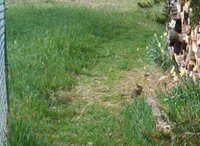Marguerite mentioned blackberries in her last couple of posts, and so did Lucia at Rhymes with Fuchsia. I had been twittering about the large and confusing genus Rubus, so I took the camera out for a walk in search of thorny things.
First off, what is the genus Rubus, anyway?
Rubus is the genus of a large group of plants including raspberries, dewberries, blackberries, and thimbleberries found all over North America.
When we moved to our property, I started noticing all different kinds and went to my Peterson wildflower field guide to sort out the differences.
Peterson, for once, blew me a literary raspberry of its own, saying only
Brambles (Blackberries, etc.)
Most plants of the genus Rubus are woody, prickly, or bristly shrubs, outside the scope of this book; most are problems for the specialist. Gray recognizes 205 species in our area. See A Field Guide to Trees and Shrubs for a small selection.
So I suppose as soon as I finish patiently clicking through all 237 species shown at the USDA website, I might know what I have growing here.
This is what I see when I go out walking.

These blackberries are my favorite kind for canning. They make a tall, stout cane with wicked thorns, but they also produce lots of fruit.
This is the main difference (in my mind, anyway, or maybe my local dialect) between a blackberry and a black raspberry.

When I pick a blackberry, the center stays in. When I pick a raspberry (black, red, or golden/yellow), the center comes out and the edible berry is hollow.
Let's take another look at those thorns:
 Ouch!
Ouch!Last year I found a happy hybrid: right down the path from the thorny ones, in the midst of a patch of trailing or sprawling thornless blackberries, a thornless blackberry with stout canes came up.

It's in a shady spot, so the fruit is not ripe yet.
Check out the lack of thorns!

I want to move them into the sun, but I don't want to kill them. I'll probably bury the leafy tip in a pot of soil and let it root.
I think this one is some kind of dewberry, but it never fruits enough to be sure. It has a fuzz of thorns, but they're bendy.

Then I have
Rubus something-or-other with completely different leaves, a palmate leaf like a Virginia creeper.

These are the sprawling brambles I have everywhere, the ones that like to rip my ankles to shreds:

The leaves turn an incredibly beautiful deep red in the fall, and in the spring they have such a delicate, crinkly-petalled white flower. Before I found the tall-caned ones, I used to pick and can these guys.
Their thorns don't look like much, but there are plenty of them.

Last of all, here is a black raspberry cane, next year's fruiting cane.

I can't show any berries for them, because their season has ended.
(And so has this post.)
Labels: gardening, geekery, nature




















































